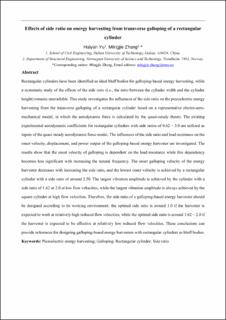| dc.contributor.author | Yu, Haiyan | |
| dc.contributor.author | Zhang, Mingjie | |
| dc.date.accessioned | 2021-11-15T11:42:30Z | |
| dc.date.available | 2021-11-15T11:42:30Z | |
| dc.date.created | 2021-11-12T18:22:05Z | |
| dc.date.issued | 2021 | |
| dc.identifier.issn | 0360-5442 | |
| dc.identifier.uri | https://hdl.handle.net/11250/2829564 | |
| dc.description.abstract | Rectangular cylinders have been identified as ideal bluff bodies for galloping-based energy harvesting, while a systematic study of the effects of the side ratio (i.e., the ratio between the cylinder width and the cylinder height) remains unavailable. This study investigates the influences of the side ratio on the piezoelectric energy harvesting from the transverse galloping of a rectangular cylinder based on a representative electro-aero-mechanical model, in which the aerodynamic force is calculated by the quasi-steady theory. The existing experimental aerodynamic coefficients for rectangular cylinders with side ratios of 0.62–3.0 are utilized as inputs of the quasi-steady aerodynamic force model. The influences of the side ratio and load resistance on the onset velocity, displacement, and power output of the galloping-based energy harvester are investigated. The results show that the onset velocity of galloping is dependent on the load resistance while this dependency becomes less significant with increasing the natural frequency. The onset galloping velocity of the energy harvester decreases with increasing the side ratio, and the lowest onset velocity is achieved by a rectangular cylinder with a side ratio of around 2.50. The largest vibration amplitude is achieved by the cylinder with a side ratio of 1.62 or 2.0 at low flow velocities, while the largest vibration amplitude is always achieved by the square cylinder at high flow velocities. Therefore, the side ratio of a galloping-based energy harvester should be designed according to its working environment: the optimal side ratio is around 1.0 if the harvester is expected to work at relatively high reduced flow velocities, while the optimal side ratio is around 1.62–2.0 if the harvester is expected to be effective at relatively low reduced flow velocities. These conclusions can provide references for designing galloping-based energy harvesters with rectangular cylinders as bluff bodies. | en_US |
| dc.language.iso | eng | en_US |
| dc.publisher | Elsevier | en_US |
| dc.rights | Attribution-NonCommercial-NoDerivatives 4.0 Internasjonal | * |
| dc.rights.uri | http://creativecommons.org/licenses/by-nc-nd/4.0/deed.no | * |
| dc.title | Effects of side ratio on energy harvesting from transverse galloping of a rectangular cylinder | en_US |
| dc.type | Peer reviewed | en_US |
| dc.type | Journal article | en_US |
| dc.description.version | acceptedVersion | en_US |
| dc.rights.holder | This is the authors' accepted manuscript to an article published by Elsevier. Locked until 19.3.2023 due to copyright restrictions. The AAM is made available under the CC-BY-NC-ND 4.0 license http://creativecommons.org/licenses/by-nc-nd/4.0/ | en_US |
| dc.source.volume | 226 | en_US |
| dc.source.journal | Energy | en_US |
| dc.identifier.doi | 10.1016/j.energy.2021.120420 | |
| dc.identifier.cristin | 1954213 | |
| cristin.ispublished | true | |
| cristin.fulltext | postprint | |
| cristin.qualitycode | 2 | |

